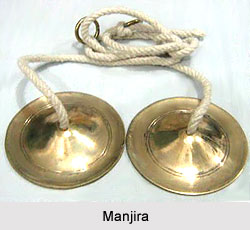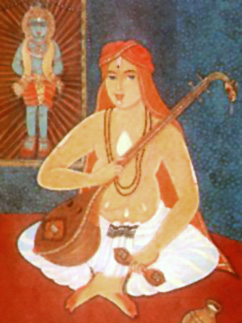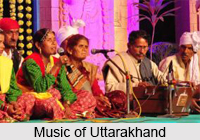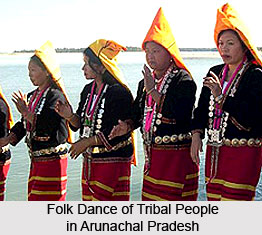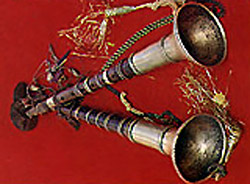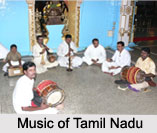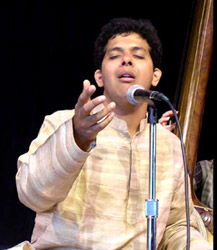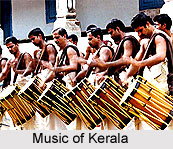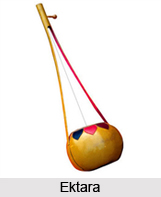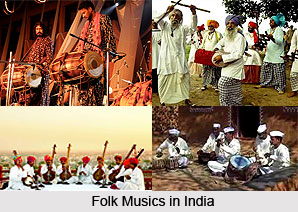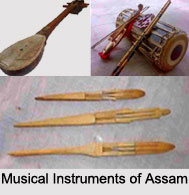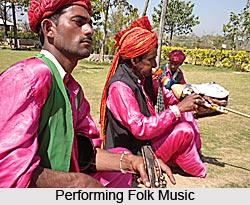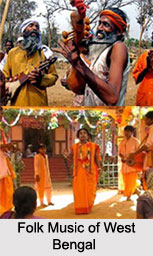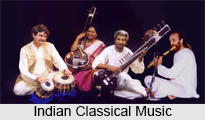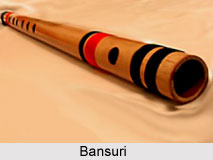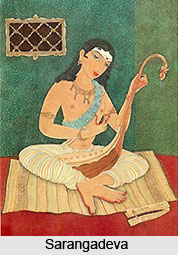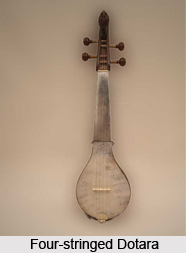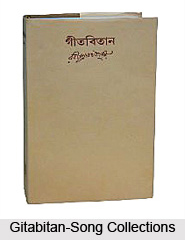 Quite ideally therefore amongst the Bengali classics, Rabindra Sangeet is in one of the top positions. India`s cultural treasure finds an articulate dimension amidst the celestial pleasure of Rabindra Sangeet, which refers to a complete body of lyrical artistry, composed and written by the great Nobel Laureate Rabindranath Tagore. "I get lost in my songs and then I think those are my best work; … if all my poetry is forgotten, all my songs will remain with my countrymen…they have a great beauty …. I leave them as a legacy." Rabindranath Tagore.
Indeed! This is what best describes Rabindra Sangeet where the poet in his own own words has redefined the very term "music" time and again, in the most tuneful way.
History of Rabindra Sangeet
Quite ideally therefore amongst the Bengali classics, Rabindra Sangeet is in one of the top positions. India`s cultural treasure finds an articulate dimension amidst the celestial pleasure of Rabindra Sangeet, which refers to a complete body of lyrical artistry, composed and written by the great Nobel Laureate Rabindranath Tagore. "I get lost in my songs and then I think those are my best work; … if all my poetry is forgotten, all my songs will remain with my countrymen…they have a great beauty …. I leave them as a legacy." Rabindranath Tagore.
Indeed! This is what best describes Rabindra Sangeet where the poet in his own own words has redefined the very term "music" time and again, in the most tuneful way.
History of Rabindra Sangeet
Rabindra Sangeet merges fluidly into Tagore`s literature, most of which are poems or parts of novels, stories, or plays alike were lyricised. Influenced by the thumri style of Hindustani music, they ran the entire gamut of human emotion, ranging from his early dirge-like Brahmo devotional hymns to quasi-erotic compositions. They emulated the tonal color of classical ragas to varying extents. Some songs mimicked a given raga`s melody and rhythm faithfully, others newly blended elements of different ragas. Yet about nine-tenths of his work was not bhanga gaan, the body of tunes revamped with fresh value from selected Western, Hindustani, Bengali folk and other regional flavours external to Tagore`s own ancestral culture.
Tagore belonged to a family of scholars and musicians. As a child he was always surrounded by an artistic atmosphere at home. Rabindranath"s early training in music was deeply influenced by the Bishnupur Gharana. He grew up listening, learning and absorbing the Dhrupads and Khayal (both forms of Hindustani classical music) traditions. His beloved brother Jyoti Dada (Jyotindranath Tagore) would create tunes on Piano and encourage young Rabindranath to compose verses to match the Raga-based melodies. What started as a kind of playful exercise for the young Rabindranath eventually bloomed into a genre in itself, known as Rabindra sangeet.
For Bengalis, the songs` appeal, stemming from the combination of emotive strength and beauty described as surpassing even Tagore`s poetry, was such that the modern review observed that "there is no cultured home in Bengal where Rabindranath`s songs are not sung or at least attempted to be sung, even illiterate villagers sing his songs".
In 1971, Amar Shonar Bangla became the national anthem of Bangladesh. It was written ironically to protest the 1905 Partition of Bengal along communal lines: lopping Muslim-majority of East Bengal from Hindu dominated West Bengal to avert a regional bloodbath. Tagore saw the partition as a ploy to upend the independence movement, and he aimed to rekindle Bengali unity and tar communalism. Jana Gana Mana was written in shadhu-bhasha, a Sanskritised register of Bengali, and is the first of five stanzas of a Brahmo hymn that Tagore composed. It was first sung in 1911 at a Calcutta session of the Indian National Congress and was adopted in 1950 by the Constituent Assembly of the Republic of India as its national anthem.
Features of Rabindra Sangeet
Varied themes, rich quality and most importantly that close link to the heart, which Rabindra Sangeet establishes, has made it the music of the common people whilst whispering the saga of love, nature, languishment and eternal worshipping of the omnipresent.
Traditional Hindustani Khayal music gives supreme importance to melody, lyrics play a secondary role. Pure classical music without any meaningful words did not attract Tagore. He preferred to set words to the classical tune. One cannot listen to a Tagore song as a pure classical Raga. The poetry is an integral part and the appropriate Raga is often chosen to bring out the mood of the poetry. For example, the songs in the category of Prakriti or Nature are divided into six seasons and the songs of certain seasons would be based on one of the Ragas associated with that season. Similarly, if the lyrics describe the morning, the tune will typically be based on one of the morning Ragas. The beauty of Tagore"s song was a perfect fusion of the lyric and the Raga. They complimented each other to create a different genre of music. He also modified and sometimes created Talas (rhythmic beats) to suit his requirements.
One of the significant facets of Rabindra Sangeet is therefore that subtle presence of the classical element, which further aids in evoking that right mood for the song. This is one of the main reasons why the celestial tonal color of the ragas so very well complements with the emotion of the songs. Many of the Rabindra Sangeet therefore has a reference with the partial accord to the ragas like Megh, Bhairavi etc.
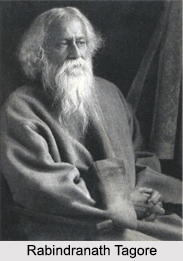 Originated as an emblematic form of music even today Rabindra Sangeet is still contemporary laced with its entire innovativeness. Apart from the "thumri style" and "Bhakti style" the lighter variety of Rabindra Sangeet, which is derived from the Indian folks like Bhatiyali, Kirtan, echoes the tune of the soil.
Originated as an emblematic form of music even today Rabindra Sangeet is still contemporary laced with its entire innovativeness. Apart from the "thumri style" and "Bhakti style" the lighter variety of Rabindra Sangeet, which is derived from the Indian folks like Bhatiyali, Kirtan, echoes the tune of the soil.
Artists of Rabindra Sangeet
India`s classical music tradition has a rich history of its own, which is again decked up by the titanic intellect, and romanticism of Rabindranath Tagore. The breathtaking fusion of literary genius and musicianship of Tagore teamed with the artistry of the Rabindra Sangeet singers like Pankaj Mullick, Suchitra Mitra, Konika Bandopadhyay and Debobrata Biswas, made this particular genre of music to stand apart whilst illustrating the beliefs, tradition and philosophy of the Indians. Rabindra Sangeet, the individual genre of music therefore reflects the authentic aura of India from the remote past and is still one of the most cherished art forms.
On certain instance again the harmonious accord of ragas with the melodious presence of the rhythm, tune, melody and of course the very pulse of the Bengali lyrics adds that little extra to this typical genre of Indian music while making it the song to dance, sing, recite and above all to feel.
Songs from Rabindra Sangeet
Rabindra Sangeet therefore with its sheer majesty, utmost beauty and ultimate passion combines the classical characteristics with the elements of the songs of soil to make the music truly stand apart as an insignia of Indian classical music. The songs are affectionately called Rabindra Sangeet, and cover topics from humanism, structuralism, introspection, psychology, romance, yearning, nostalgia, reflection, modernism. Tagore primarily worked with two subjects – first, the human being, the being and the becoming of that human being, and second, Nature, in all her myriad forms and colours, and of the relationship between the human being and Nature and how Nature affects the behavior and the expressions of human beings.
Bhanusimha Thakurer Padavali (or Bhanusingher Podaboli), one of Tagore`s earliest works in music, was primarily in a language that is similar and yet different from Bengali – this language, Brajabuli. It was derived from the language of the Vaishnav hymns, and of texts like Jayadeva`s Gita Govinda, some influences from Sanskrit can be found, courtesy Tagore`s extensive homeschooling in the Puranas, the Upanishads, as well as in poetic texts like Kalidasa`s Meghaduta and Abhigyanam Shakuntalam.
Tagore was one of the greatest narrators of all time, and throughout his life, we find a current of narration through all his works that surges with upheavals in the psyche of the people around him, as well as with the changes of seasons. A master of metaphor, it is often difficult to identify the true meaning that underlies his texts, but what is truly great about Tagore, is that his songs are identifiable with any and every possible mood, with every possible situation that is encountered by a person in the course of life. This truly reinforces the notion that Rabindra sangeet has at its heart some unbelievably powerful poetry.
Book on Rabindra sangeet
The book forming a collection of all 2,233 songs written by Rabindranath is called Gitabitan and forms an important part of extant historical materials pertaining to Bengali musical expression. The Swarabitan, published in 64 volumes, includes the texts of 1,721 songs and their musical notation.
